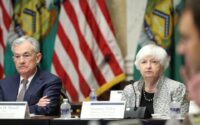Gold Expert Talks 2024 Outlook, Plus Forecast for Silver, Platinum and Palladium
The start of 2024 has been strong for gold, which has breached US$2,100 per ounce and approached US$2,200.
Could the yellow metal move higher, and could its elevated price generate more interest among investors? What about silver, platinum and palladium — what does 2024 have in store for these precious metals?
John Reade, chief market strategist at the World Gold Council, was on hand at the 2024 edition of the Prospectors & Developers Association of Canada (PDAC) convention to discuss his outlook for precious metals this year and beyond. Read on for an overview of his presentation, which focused on gold, but also covered silver, platinum and palladium.
Key gold demand trends in 2023
2023 was a strong year for gold despite the headwind of high interest rates. Not only did the metal hit a new record level late in the period, but it also outperformed most asset classes apart from US equities.
So what has been driving demand for gold over the past year? Reade explained many factors were at play, but noted that jewelry buying has remained resilient despite being a market segment that is sensitive to rising prices.
“The gold price was US$250 in 1999 and 2001, and is US$2,000 now. The gold price has increased over the last six or seven years, and yet jewelry demand is pretty steady. I think that shows a very strong underlying interest in gold for jewelry, and that interest comes from emerging markets, principally India and China,” he said.
Reade believes continued demand for gold jewelry indicates a broader tolerance within the market for US$2,000 gold.
Also contributing to strong gold demand in 2023 was the technology sector, which consumed 300 metric tons (MT) of the yellow metal following years of pressure following the COVID-19 pandemic.
However, gold bar and coin investment still made up the largest demand category. Reade pointed out that while there were 244 MT of outflows from exchange-traded funds (ETF) in 2023, marking a third consecutive annual decline, bar and coin demand remained strong, with 1,200 MT being traded, a 3 percent decline year-on-year.
This slight decline in bar and coin demand can be attributed to decreased buying in western markets, particularly Germany, said Reade. “Probably the most worrying factor in thegold marketat the moment for me is the collapse in demand we’ve seen in Germany — a 70 percent fall in what was the biggest western market for bars and coins,” he said, noting that the World Gold Council continues to closely monitor this situation.
Reade said the precipitous drop in German demand was due to factors such as high interest rates and elevated prices in consumer energy markets, with these pressures causing investors to move to the sidelines and rein in spending.
While German gold investment declined last year, demand for the yellow metal was taken up elsewhere. “In contrast, we’ve seen a big bounce-back in gold demand in China as the economy opened up, and we’re seeing into 2024 tremendous interest from Chinese investors to buy gold bars and gold coins,” said Reade.
Central banks still strong gold buyers
Reade also highlighted central bank gold buying, calling it the “biggest story” on the demand side.
Following selloffs of gold for the 22 years leading up to the global financial crisis in 2008, emerging market central banks began to purchase 500 MT of gold per year between 2010 and 2021. This represented 10 percent of a 5,000 MT per year market. These numbers doubled after the pandemic, with countries like China, Poland and Singapore leading the way.
According to Reade, one factor that’s changed considerably when it comes to central bank gold buying is the amount going unreported; this suggests there is more buying going on than the central banks say there is.
Looking at why central banks are stocking up on gold, Reade said inflation is one reason. He also noted that emerging market central banks see possible threats to the US dollar’s status as the world’s reserve currency.
“There’s a recognition amongst the emerging market central banks, who have trillions of dollars of foreign exchange reserves, that in the future, other economies will be big and important too, and probably will become competitors for the US reserve currency status,” he said, mentioning China and India as possibilities.
Reade continued, “Their currencies aren’t ready yet to be reserve currencies. Yet demand for gold is driven very much by the performance of those and other emerging market economies.”
The final point he thinks is pushing central bank gold buying is Russia’s invasion of Ukraine. “The sanctioning of (Russia’s) reserves. Gold is an asset that central banks can hold in their own country that is resistant to western sanctions, and that’s becoming a lot more attractive,” Reade told the audience at PDAC.
Best- and worst-case gold price scenarios
Reade noted that there are many macroeconomic and geopolitical factors that influence thegold market However, in the short term, what happens in the financial markets will determine the metal’s price.
He noted that back in December, a soft landing was the general consensus among experts; some were calling for a recession, while very few were forecasting a “no landing” outcome.
“Things have shifted somewhat now. I’d say more people are thinking about a no landing economy than there were before. Not very many people are talking about a recession, such is the strength of the US economy,” Reade said.
Looking at how each scenario would impact gold, he suggested that a hard landing would have the best results, while a soft landing gold would still see gold do well, but would also see equities to continue to roll ahead.
A no landing scenario would be the least favorable for the yellow metal.
“In other words, growth in the states doesn’t slow down enough to trigger (interest rate cuts), and possibly inflation stays high enough that we could even see some hikes. That is the worst of all scenarios for 2024 for gold. If we don’t get rate cuts, gold probably will struggle to exceed or even match what we saw in 2023,” he said.
Reade also spoke about how the US election could affect demand for gold in the coming months as two divisive candidates face off for the presidency. Their vastly differing foreign policies could create volatility for the markets and the US dollar, and investors could seek out gold as a safe-haven asset.
“A victory by the Republican party may lead to risks of a more isolationist US economy,” said Reade. “As it is, the dollar is showing signs of people moving slowly away from it and looking for other assets to trade with or have in central bank reserves — this could accelerate if some of the policies being spoken about by one of the candidates were to come true.”
Silver, platinum and palladium outlook
While signs are pointing togold marketstrength in 2024, the outlook isn’t looking as optimistic for silver, platinum and palladium. Of the three, Reade sees silver as having the greatest potential.
In 2022, silver saw strong demand from India, which was importing record amounts of the white metal. But that demand failed to carry over into 2023, and silver had a somewhat disappointing year. During a recent trip to Singapore, Reade saw another reversal in the works, with Indian demand once again on the rise.
“If that’s the case, watch for … inventories heading lower again for silver and for things to get interesting,” he said.
However, Reade was also pragmatic, noting that Indian demand alone won’t create a positive shift in silver.
“I personally think we’re going to need a bit of recovery in China. Its industrial demand for silver is so important that if the economy there is lagging, that might tend not to make this happen,” he explained. Pointing to the lagging gold-silver ratio, Reade added that there is potential for silver investors to do very well.
When it comes to platinum and palladium, Reade doesn’t see a positive narrative. Both metals are sitting in surplus positions, with their primary use being as catalysts for vehicles with internal combustion engines. With strong production continuing out of South Africa and with considerable amounts of the metals contained in vehicles that will eventually be recycled, the possibility of higher pricing in the short term isn’t good.
With elections approaching in South Africa at the end of May, there aren’t likely to be cuts in platinum output until later in the year, if at all, but Reade still sees more upside for platinum than palladium.
“Platinum is a metal that traded at a premium to gold for almost all my life, for the last 70 years. So I would say I have more faith in the long-term prospects,” he said.
Don’t forget to follow us @INN_Resource for real-time updates!
Securities Disclosure: I, Dean Belder, hold no direct investment interest in any company mentioned in this article.
The views and opinions expressed herein are the views and opinions of the author and do not necessarily reflect those of Nasdaq, Inc.
[ad_2]
Source link


